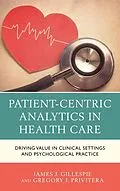In Patient-Centric Analytics in Health Care: Driving Value in Clinical Settings and Psychological Practice, James J. Gillespie and Gregory J. Privitera introduce a framework that explores the utility of analytics for managing care that is based on six key inputs of the health care system: patients, policy makers, providers, pharmacies, pharmaceuticals, and payers. Understanding the roles of these 6 P's and the utility of analytics to promote data-driven decision models can lead to new innovations. These improvements can enhance quality, increase access, and reduce costs, and thereby drive value for the most important stakeholders in health care: the patients. As the accessibility and volume of data continues to increase, there is a growing desire to utilize data to guide and optimize decision-making in health care environments. There is a wealth of data in health care organizations and much of it is not fully utilized. In today's climate, these organizations are under increased regulatory and financial pressures to deliver measurable value, particularly as it relates to the quality of patient care in clinical and diagnostic settings. This book includes short contributions from practitioners, including Laurie Branch, Puneet Chahal, Patrick C. Cunningham, Star* Cunningham, Matthew Dreckmeier, Joseph P. Gaspero, Sherri Matis-Mitchell, Gail Mayeaux, Edwin K. Morris, Plamen Petrov, Steven Press, Andrew J. Privitera, Derek Walton, and Daniel Yunker.
Autorentext
By Gregory J. Privitera and James J. Gillespie
Zusammenfassung
In Patient-Centric Analytics in Health Care: Driving Value in Clinical Settings and Psychological Practice, James J. Gillespie and Gregory J. Privitera introduce a framework that explores the utility of analytics for managing care that is based on six key inputs of the health care system: patients, policy makers, providers, pharmacies, pharmaceuticals, and payers. Understanding the roles of these 6 P's and the utility of analytics to promote data-driven decision models can lead to new innovations. These improvements can enhance quality, increase access, and reduce costs, and thereby drive value for the most important stakeholders in health care: the patients. As the accessibility and volume of data continues to increase, there is a growing desire to utilize data to guide and optimize decision-making in health care environments. There is a wealth of data in health care organizations and much of it is not fully utilized. In today's climate, these organizations are under increased regulatory and financial pressures to deliver measurable value, particularly as it relates to the quality of patient care in clinical and diagnostic settings. This book includes short contributions from practitioners, including Laurie Branch, Puneet Chahal, Patrick C. Cunningham, Star* Cunningham, Matthew Dreckmeier, Joseph P. Gaspero, Sherri Matis-Mitchell, Gail Mayeaux, Edwin K. Morris, Plamen Petrov, Steven Press, Andrew J. Privitera, Derek Walton, and Daniel Yunker.
Inhalt
Section I: The Landscape of Data AnalyticsChapter 1: A Pentagonal Framework for the 6 Ps in Health CareChapter 2: Taxonomy of Analytics in the Health-Care Space Chapter 3: The Statistical Toolbox for Analytics Chapter 4: Managing Value in Health Care: Adopting a Culture of AnalyticsSection II: Data Analytics Across the 6 PsChapter 5: Data Analytics: Patients Chapter 6: Data Analytics: Policy Makers Chapter 7: Data Analytics: Providers Chapter 8: Data Analytics: Pharmacies Chapter 9: Data Analytics: Pharmaceuticals Chapter 10: Data Analytics: Payers Section III: Best Practices in Data AnalyticsChapter 11: Data Quality: Meaningful and Systematic UseChapter 12: Exposition of Data: Managing Data Queries and Sampling Chapter 13: Driving Actionable Data: Triggers, Indicators, and Statistical InferenceChapter 14: Making Health Care Smarter
